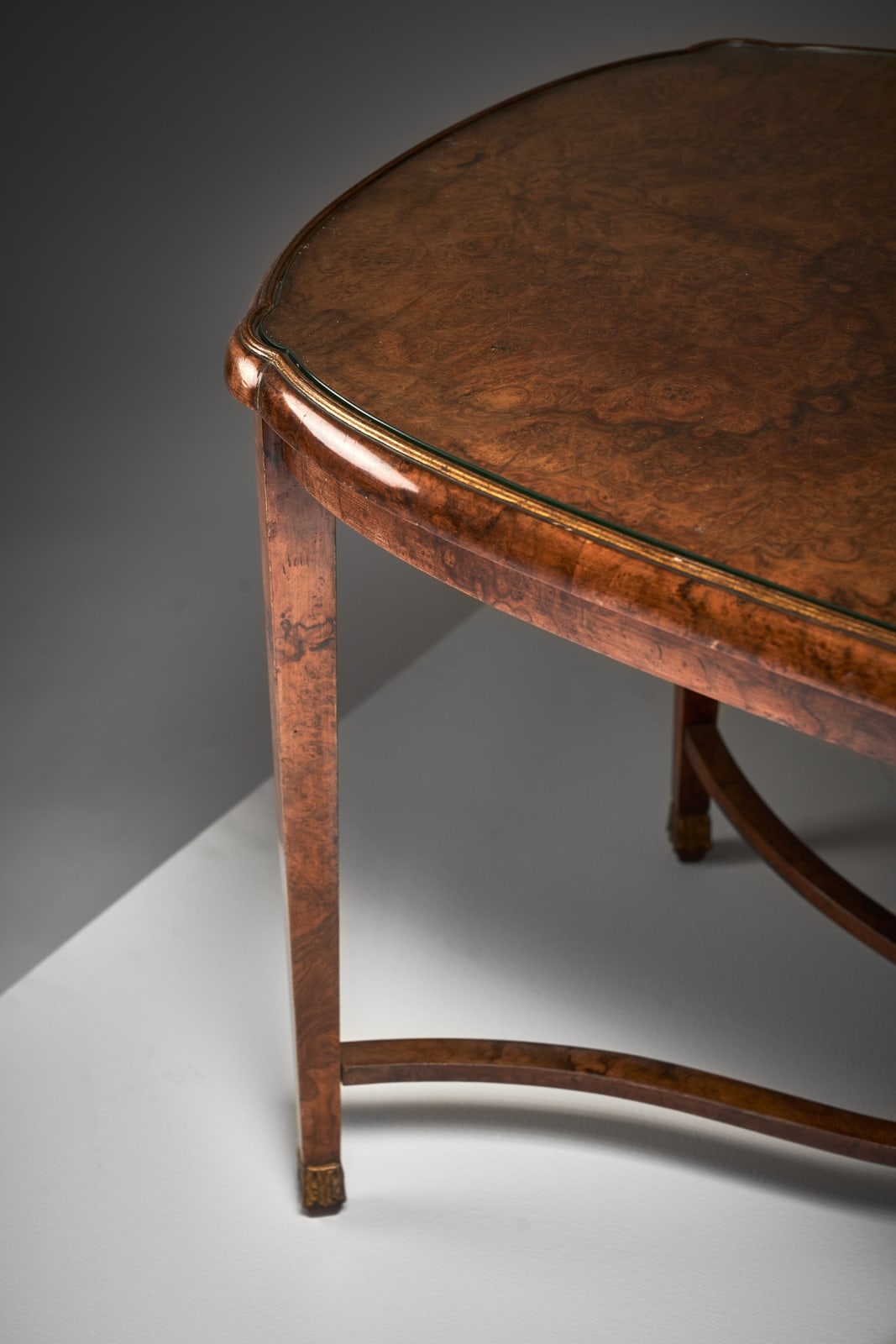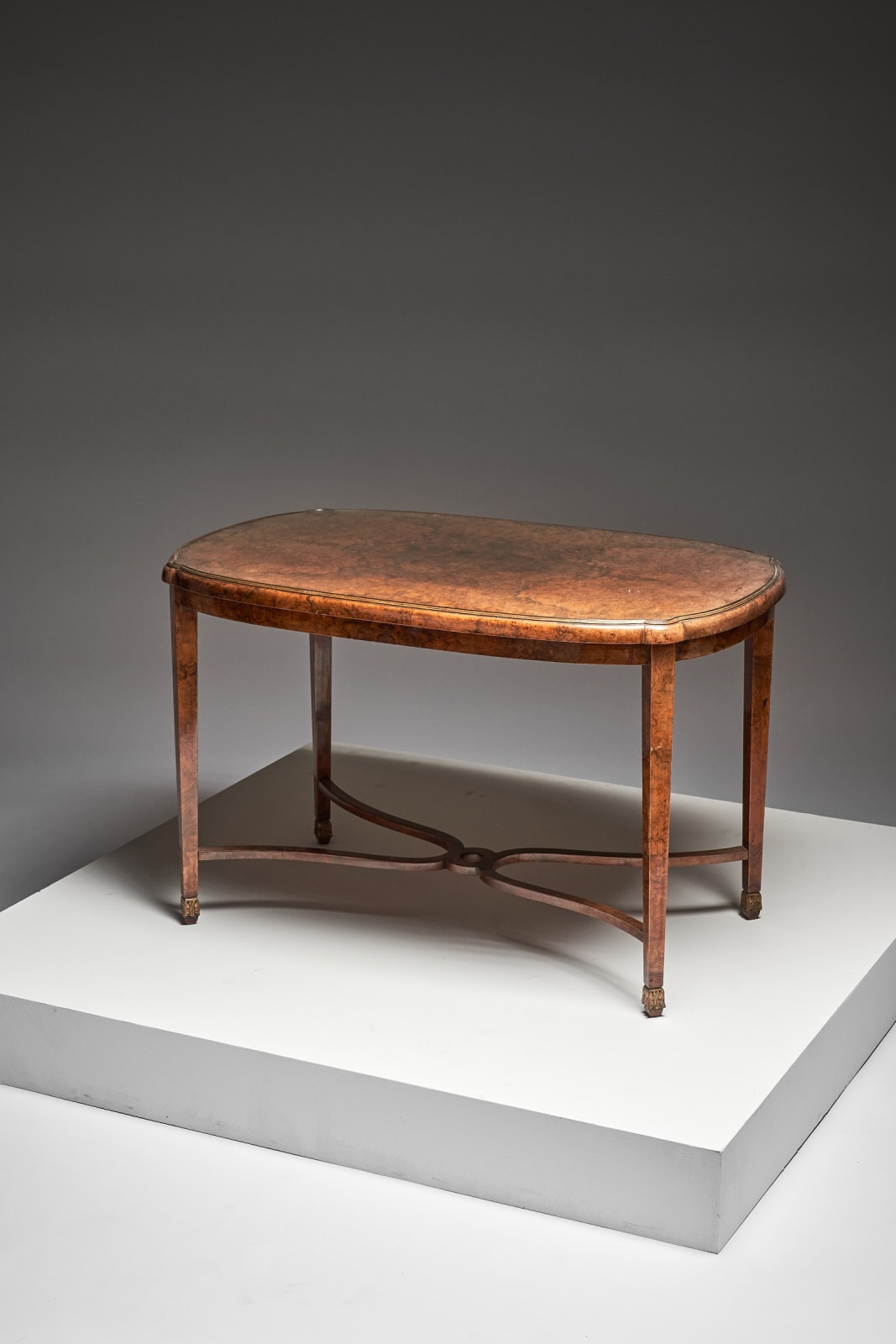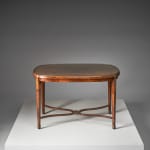Werkhuizen Franck - Maison Franck (Belgium, 1900-1962)
At the bottom acanthus motifs in gilded bronze
Further images
The Maison Franck firm in Antwerp had three activities:
1) Furniture production
2) Interior decoration
3) Antiques trade
The first Maison Franck business, run by Mr and Mrs Franck, was located in Kuipersstraat in Antwerp and grew from a modest wallpaper shop to a thriving decoration company.
Their son Frans Franck (1872-1932), a talented draughtsman, was sent to Paris as an apprentice of an (unknown) furniture maker. This training made him sensitive to the new trends in English decorative arts and the work of the famous artist, writer and designer William Morris (1834-1896); the writer, poet, critic and painter John Ruskin (1819-1900); the artist and book illustrator Walter Crane (1845-1915) among others. Back in Belgium, father Franck involved his son Frans and his brother Charles (1870-1935) in decorating the halls for the Second World's Fair in Antwerp in 1894 working with a large number of sheets of parchment. They accomplished this task with great accuracy and speed, reason enough for their father to leave the management of the Maison Franck company to them: Charles was put in charge of management and administration and Frans of the decorative side of the business. The company flourished and during the interwar period employed around 150 craftsmen, including upholsterers, gilders, painters, sculptors and various specialists.
But both brothers also became very important cultural promoters of the Antwerp art scene at the beginning of the 20th century. They wanted to attract new artistic movements to Antwerp and founded 'De Kapel', which soon grew into the new artistic association Kunst van Heden - Art Contemporain. They promoted young artists such as the modernist and pre-expressionist sculptor and painter Rik Wouters (1882-1916); the expressionist sculptor and painter Constant Permeke (1886-1952) the main figure of the Belgian avant-garde of the late 19th century and important precursor to the development of expressionism in the early 20th century James Ensor (1860-1949); and the avant-garde painter Floris Jespers (1889-1965) with his mix of styles (expressionism, cubism, surrealism) and his brother Oscar Jespers (1887-1970), an important modernist sculptor. Kunst van Heden invited many members of the international art scene including Chagall, Van Gogh, Klee and Kandinsky. Frans was an art collector himself and, as the first and enthusiastic promoter of Ensor, he had works by him in his private collection. Unlike his artistic commitment, Frans Franck's international and avant-garde tastes were never modernist. He did not design abstract forms, did not use contrasting colours and had no interest in mass-producing cheap furniture. Frans sadly died in 1932 after an unfortunate fall while taking a family photo on the Belgian coast.
Franck's son Francis and his business partner Paul Pieters took charge of the company on 1 June 1932. Under Francis' charismatic and creative leadership, the Franck company continued to flourish. In 1962, two years before his death, Maison Franck ceased to exist, but Maison Décor, a new and smaller company, had been founded by one of Francis' assistants, Frans Lemmens. He continued to furnish interiors in the tradition of Maison Franck.
Maison Franck's furniture trade mark was undoubtedly the use of tortoiseshell. The use of tortoiseshell veneer for furniture in Antwerp went back to the first half of the 17th century. Even then, Antwerp was known as the production and export centre of tortoiseshell-veneered cabinets. Since Frans Franck was also an antiques dealer, buying and selling Antwerp cabinets from the city's Golden Age must have been his inspiration for his 20th-century designs, using tortoiseshell veneer techniques and some stylistic features. The effect of red tortoiseshell was obtained by glueing the transparent tortoiseshell veneer on a red painted surface with vermilion powder. Yellow tortoiseshell was obtained by glueing the transparent veneer onto a gold leaf background. As with Art Deco designs, inspiration was also found in French or English classicist furniture.The book by G.M. Ellwood with English 18th century designs – such as models by Thomas Sheraton - that Franck owned must also have been a source of inspiration: it shows some drawings of Sheraton-furniture legs decorated with carved tassels (‘floches’) and a demi-lune side table on square tapering legs completely veneered in tortoiseshell. The creative Franck made this ‘floche’ motif and tortoiseshell technique characteristic for his designs. Every ‘floche’ was carved and chiselled separately by hand. In combination with tortoiseshell this kind of 'Franck furniture' was very expensive without being really profitable, but it became his trademark. Another typical Franck feature was the use of Chinese lacquer panels, for example for cabinet doors. Thanks to their brother Louis Franck - a Belgian Minister of State – who had good contacts with the colonies and China, Franck imported - at first old - Coromandel lacquer panels. When the demand for lacquerware increased, new ones were made locally. The Franck tortoiseshell Art Deco furniture is usually quite different from the pieces he made in the international Art Deco style: Franck travelled frequently to Paris and he owned ‘Croquis de Ruhlmann’, the book with sketches by the famous Parisian furniture and interior designer Jacques-Émile Ruhlmann (1879-1933). Besides the luxury tortoiseshell and lacquered furniture, Franck designed and produced a considerable variety of chairs, tables, cabinets, etc. in oak and walnut in an eclectic historicizing style combining for example 17th and 18th century design elements. Sometimes the historicist designs remained close to the original style, but they were provided with a new function. For example a neoclassical cabinet that originally had drawers and a sliding top, inspired Franck for a liquor cabinet. Franck adapted constantly his designs instead of sticking to a limited number of standard models. Custom-designed creations were the rule at a time when ideas of mass production and standardisation were taking hold.
Maison Franck was not only engaged in furnishing houses, but also functioned as an interior design company with French's own creations or pieces sold in their antiques shop. The interior design business was comprehensive and involved in every detail of a project: carpentry, stairs, windows, doors, flooring, lighting, wallpaper, curtains, upholstery, and so on.
When the company that Maison Franck had taken over in 1965 was liquidated, the remains of Maison Franck's archives were sold in 1998 through the Antwerp auction house Amberes. These archives included furniture construction drawings from about 1910 to 1950; a set of furniture and interior watercolour drawings; a register of the various tortoiseshell table designs from 1920 to 1935; an (incomplete) ledger of 14 books of sales records of general antiques, furniture and objects between 1900 and 1961.





